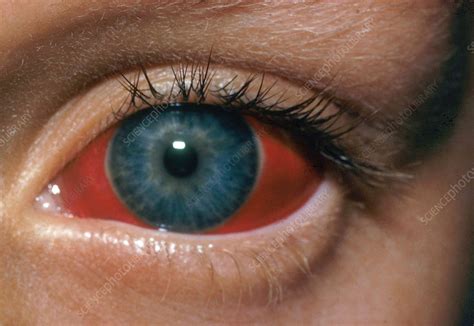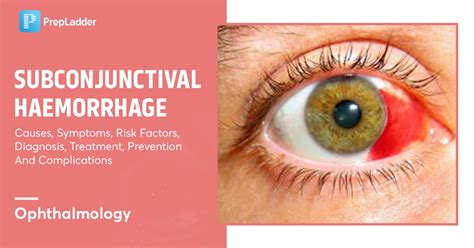Intro
Discover Conjunctival Hemorrhage symptoms, causes, and treatments. Learn about subconjunctival hemorrhage, eye bleeding, and broken blood vessels in the eye, and understand the differences between conjunctivitis and hemorrhage.
A conjunctival hemorrhage, also known as a subconjunctival hemorrhage, is a condition where a small blood vessel in the conjunctiva, the thin membrane covering the white part of the eye, breaks and bleeds. This can be a frightening experience, especially if it happens suddenly and without warning. However, in most cases, a conjunctival hemorrhage is a harmless condition that resolves on its own within a few weeks. Understanding the symptoms and causes of a conjunctival hemorrhage can help alleviate concerns and promote timely medical attention if necessary.
The symptoms of a conjunctival hemorrhage can vary depending on the severity of the condition. In general, people with a conjunctival hemorrhage may experience a range of symptoms, including a bright red patch on the white part of the eye, which can be accompanied by a feeling of fullness or pressure in the eye. Some individuals may also experience mild eye irritation, such as itchiness, burning, or a sensation of having something in the eye. However, it's essential to note that a conjunctival hemorrhage is usually painless and does not affect vision.
In some cases, a conjunctival hemorrhage can be a sign of an underlying medical condition, such as high blood pressure, diabetes, or a blood clotting disorder. Therefore, it's crucial to seek medical attention if the hemorrhage is severe, recurs frequently, or is accompanied by other symptoms, such as eye pain, vision changes, or discharge. A comprehensive eye examination can help determine the cause of the hemorrhage and rule out any underlying conditions that may require medical attention.
What is a Conjunctival Hemorrhage?

Causes of Conjunctival Hemorrhage
The causes of a conjunctival hemorrhage can be divided into several categories, including: * Trauma: A blow to the eye or a foreign object in the eye can cause a conjunctival hemorrhage. * Increased pressure: High blood pressure, coughing, sneezing, or heavy lifting can increase the pressure in the blood vessels of the conjunctiva, leading to a hemorrhage. * Infection: Certain infections, such as conjunctivitis, can cause a conjunctival hemorrhage. * Allergies: Allergic reactions can cause the blood vessels in the conjunctiva to become inflamed and break, leading to a hemorrhage. * Medical conditions: Certain medical conditions, such as diabetes, high blood pressure, or blood clotting disorders, can increase the risk of a conjunctival hemorrhage.Symptoms of Conjunctival Hemorrhage

Treatment Options for Conjunctival Hemorrhage
In most cases, a conjunctival hemorrhage resolves on its own within a few weeks without any treatment. However, if the hemorrhage is severe or recurrent, medical attention may be necessary. Treatment options for a conjunctival hemorrhage may include: * Applying cold compresses to reduce swelling and discomfort * Using artificial tears to lubricate the eye and reduce irritation * Avoiding heavy lifting, bending, or strenuous activities that can increase pressure in the blood vessels * Managing underlying medical conditions, such as high blood pressure or diabetes, to reduce the risk of recurrenceDiagnosis of Conjunctival Hemorrhage

Risk Factors for Conjunctival Hemorrhage
Certain risk factors can increase the likelihood of developing a conjunctival hemorrhage. These include: * Age: Conjunctival hemorrhages are more common in older adults. * High blood pressure: Uncontrolled high blood pressure can increase the risk of a conjunctival hemorrhage. * Diabetes: People with diabetes are more likely to develop a conjunctival hemorrhage due to damage to the blood vessels. * Blood clotting disorders: Certain blood clotting disorders, such as hemophilia, can increase the risk of a conjunctival hemorrhage. * Trauma: A blow to the eye or a foreign object in the eye can cause a conjunctival hemorrhage.Prevention of Conjunctival Hemorrhage

Complications of Conjunctival Hemorrhage
In rare cases, a conjunctival hemorrhage can lead to complications, such as: * Vision problems: A large hemorrhage can cause blurred vision or double vision. * Eye inflammation: A conjunctival hemorrhage can cause inflammation in the eye, which can lead to scarring and vision problems. * Recurrence: A conjunctival hemorrhage can recur, especially if the underlying cause is not addressed.What is the main cause of a conjunctival hemorrhage?
+The main cause of a conjunctival hemorrhage is the breaking of a small blood vessel in the conjunctiva, which can be due to various factors, including trauma, increased pressure, infection, allergies, or underlying medical conditions.
How long does it take for a conjunctival hemorrhage to heal?
+A conjunctival hemorrhage typically resolves on its own within a few weeks, usually 2-3 weeks, without any treatment. However, if the hemorrhage is severe or recurrent, medical attention may be necessary.
Can a conjunctival hemorrhage be a sign of an underlying medical condition?
+Yes, a conjunctival hemorrhage can be a sign of an underlying medical condition, such as high blood pressure, diabetes, or a blood clotting disorder. It's essential to seek medical attention if the hemorrhage is severe, recurrent, or accompanied by other symptoms.
In conclusion, a conjunctival hemorrhage is a condition that can be alarming, but it's usually harmless and resolves on its own within a few weeks. Understanding the symptoms, causes, and treatment options can help individuals seek timely medical attention if necessary. By taking preventive measures and managing underlying medical conditions, the risk of a conjunctival hemorrhage can be reduced. If you have any concerns or questions about conjunctival hemorrhages, we encourage you to share them in the comments below or consult with an eye care professional for personalized advice.
